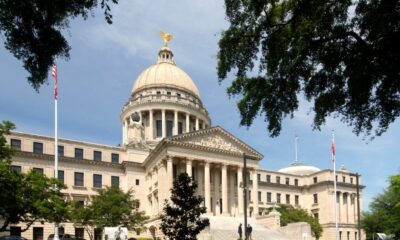Kaiser Health News
GOP Presidential Hopefuls Use Trump’s Covid Record to Court Vaccine Skeptics
Darius Tahir and Daniel Chang
Wed, 29 Nov 2023 10:00:00 +0000
Former President Donald Trump often seems proud to advertise his administration's record on speedily developing covid-19 vaccines.
On the campaign trail to win another term in the White House, though, he also has knocked the use of those very vaccines. In October, for example, he unleashed a barrage of social media attacks on Ron DeSantis' pandemic record by reposting claims that the Florida governor — who is running against him in the Republican presidential primaries — was too active in vaccinating Sunshine State residents.
In a further twist, Trump simultaneously circulated an MSNBC article suggesting DeSantis wasn't vaccinating his constituents enough.
Trump's tap dance — touting Operation Warp Speed's success at developing vaccines while criticizing vaccine use — is emblematic of how pandemic politics are intensifying broader vaccine politics. Republican presidential candidates currently trailing the former president in polls are contorting their messaging to court the party's vaccine-skeptical voters. No one embraces, without qualification, the utility of a public health measure that has saved millions of lives.
Like Trump, even the more establishment candidates can't seem to avoid embracing the anti-vaccine leanings of the party's base. Take Nikki Haley, who formerly served as governor of South Carolina and ambassador to the United Nations and has been rising in the polls. In the waning days of the Trump administration, she was pro-vaccine. But by the end of November 2021, in an interview with the Christian Broadcasting Network, she repeated dubious anti-vaccine claims: for instance, that the vaccine could undermine a woman's fertility. (Studies consistently show no effect.)
The GOP has gained the allegiance of “a minority of people who feel very strongly about the safety of vaccines,” Robert Blendon, a Harvard professor of public health, told KFF Health News. Presidential candidates are trying to use this sensibility as “a cultural issue” to signal distrust in scientists, other experts, and government authority in general, he said.
The resulting dynamic carries the risk of reaching beyond the current election cycle to affect public health policy in years to come, leading to lower rates among schoolchildren and seniors of vaccinations that protect them from measles, shingles, and HPV. Even as candidates try to weaponize this rhetoric, they've had little luck in changing the former president's front-runner status.
A recent KFF survey of adults about their plans to get vaccinated against the flu, respiratory syncytial virus, known as RSV, and covid found that partisanship remains a key predictor of how people view vaccines. Confidence in the safety of the updated covid vaccines split sharply along party lines, with more than 8 in 10 Democrats saying they trust the new shots, compared with 1 in 3 Republicans.
But unease about covid or the vaccines is not Republican primary voters' top issue — Blendon said concerns around the border, crime, and inflation are — and it's not clear vaccine-focused attacks hurt Trump.
“I didn't like his response to covid,” says an Iowa business owner featured in a critical ad from a well-funded political action committee that questioned Trump's handling of the pandemic. “I thought he probably got led a little bit by the bureaucrats,” he says, hitting Trump on his bragging about the development of the vaccine and contrasting Trump unfavorably with certain governors the man in the ad thought performed better against covid. (Images of DeSantis, otherwise unnamed, flash by.)
The result? The ad “produced a backlash” and, when audience-tested with focus groups, improved the former president's support, according to a memo summarizing the political action committee's attempts to dent the front-runner.
Candidates nonetheless are trying to make hay, acknowledged Joe Grogan, who led the Domestic Policy Council during the Trump administration. But “I think people have a lot of other targets for ire about the pandemic.”
“Trump is not at the top of the list for Republican primary voters,” Grogan said. “He's not on Page 2. Or 3, or 4. It begins with the media, the public health bureaucracy, or Big Tech companies.”
Voters have strong, yet divided and sometimes inconsistent, opinions. Some, like Joshua Sharff, 48, of Chesapeake, Virginia, are opposed to the covid vaccines and to candidates who support the shots as safe and effective. Sharff describes himself as a conservative voter who intends to support the Republican nominee for president. Though he's vaccinated, he said, “If you're a governor or a president and you tell me that I have to take a vaccine that has not been tried, that has not been tested, and ignores the science, that's a problem for me. You're taking away my freedoms as an American citizen.”
These positions have led Sharff away from Trump — and toward DeSantis, who has promoted anti-vaccine and anti-public health positions in his quest for the nomination.
Trump “pushed the vaccine very hard and recently came out, when he began to get pushback on it, that it was somebody else's fault,” Sharff said. “That's not true.”
Other Republican voters said the vaccine is not key to their vote.
“It will not sway my vote one way or another,” said Kimberly Hunt, 59, of Melville, Tennessee.
In chasing these voters, some candidates are distancing themselves from initial, pro-vaccine positions to embrace outspoken views against the shot. Vivek Ramaswamy, a biotech entrepreneur, started out as a vaccine cheerleader. But then he flipped, coming out against vaccine mandates and saying this summer that he regretted getting vaccinated. (His wife, a doctor, said she had no regrets.)
The most vocal of all is DeSantis.
Appearing on the right-leaning “PBD Podcast” on Oct. 30, DeSantis attacked Trump and “the corrupt medical swamp in D.C.” for overselling a vaccine that, despite the initial federal guidance, could not prevent infection or transmission of covid. The Centers for Disease Control and Prevention recommends the vaccine for anyone 6 months and older to protect against serious illness.
Though he initially encouraged people to get vaccinated in early 2021, DeSantis pivoted months later, banning vaccine passports for businesses and government entities, and later approving legislation prohibiting vaccine mandates in the state. That fall, he also appointed a new Florida surgeon general, physician Joseph Ladapo, whose guidance on covid vaccines contradicts CDC recommendations. DeSantis formed a Public Health Integrity Committee to assess, and generally dispute, federal health recommendations.
When the CDC released new vaccine guidance in September, Florida responded with its own advisory casting doubt on the safety of the boosters.
This anti-vaccine positioning hasn't helped DeSantis. He has been losing support nationally and is generally polling third behind Haley and Trump in New Hampshire, a key early primary state. He headlined a “medical freedom” town hall in Manchester on Nov. 1 with Ladapo as a special guest.
Among the candidates remaining, DeSantis may be the most famous convert to the politics of anti-vaccination, but, with this subject, Haley has more experience.
In the 2021 CBN interview, she said “mandates are not what America does.” But the forceful declaration is merely the end of an ambivalent record, and, for critics, demonstrates her willingness to get in sync with the demands of the GOP base. As a state legislator, she supported 2007 legislation that included a mandate for HPV vaccines before voting against it; and later, as governor, she vetoed an effort to promote those vaccinations.
Bakari Sellers — now a commentator on CNN, but at the time a lawmaker who spearheaded that bill — told KFF Health News, “That's the biggest Nikki Haley issue that there is: She kind of has her finger in the air.”
The issue of vaccines may affect the general election: Even as Trump defends his vaccine record, it's nevertheless clear he has support from the anti-vaccine crowd. An analysis by Politico, for example, found overlap among donors to independent presidential candidate Robert F. Kennedy Jr., who is staunchly opposed to vaccines, and Trump.
The willingness among politicians to assail what's traditionally looked on as a foundational achievement of public health is likely to lead to turbulence for doctors themselves. Allison Ferris, a primary care physician and an associate professor at Florida Atlantic University, said people should be listening to their doctors and not to presidential candidates about whether to take the new covid vaccines. But that message is hard to deliver in the current climate.
“It is a tricky position to be in,” said Ferris, who co-authored recently released guidance advising doctors to counsel patients that frequent covid vaccination will likely become a necessity.
——————————
By: Darius Tahir and Daniel Chang
Title: GOP Presidential Hopefuls Use Trump's Covid Record to Court Vaccine Skeptics
Sourced From: kffhealthnews.org/news/article/trump-covid-vaccines-primary-opponents/
Published Date: Wed, 29 Nov 2023 10:00:00 +0000
Did you miss our previous article…
https://www.biloxinewsevents.com/medicaid-unwinding-makes-other-public-assistance-harder-to-get/
Kaiser Health News
Medicaid Unwinding Deals Blow to Tenuous System of Care for Native Americans
Jazmin Orozco Rodriguez
Mon, 20 May 2024 09:00:00 +0000
About a year into the process of redetermining Medicaid eligibility after the covid-19 public health emergency, more than 20 million people have been kicked off the joint federal-state program for low-income families.
A chorus of stories recount the ways the unwinding has upended people's lives, but Native Americans are proving particularly vulnerable to losing coverage and face greater obstacles to reenrolling in Medicaid or finding other coverage.
“From my perspective, it did not work how it should,” said Kristin Melli, a pediatric nurse practitioner in rural Kalispell, Montana, who also provides telehealth services to tribal members on the Fort Peck Reservation.
The redetermination process has compounded long-existing problems people on the reservation face when seeking care, she said. She saw several patients who were still eligible for benefits disenrolled. And a rise in uninsured tribal members undercuts their health systems, threatening the already tenuous access to care in Native communities.
One teenager, Melli recalled, lost coverage while seeking lifesaving care. Routine lab work raised flags, and in follow-ups Melli discovered the girl had a condition that could have killed her if untreated. Melli did not disclose details, to protect the patient's privacy.
Melli said she spent weeks working with tribal nurses to coordinate lab monitoring and consultations with specialists for her patient. It wasn't until the teen went to a specialist that Melli received a call saying she had been dropped from Medicaid coverage.
The girl's parents told Melli they had reapplied to Medicaid a month earlier but hadn't heard back. Melli's patient eventually got the medication she needed with help from a pharmacist. The unwinding presented an unnecessary and burdensome obstacle to care.
Pat Flowers, Montana Democratic Senate minority leader, said during a political event in early April that 13,000 tribal members had been disenrolled in the state.
Native American and Alaska Native adults are enrolled in Medicaid at higher rates than their white counterparts, yet some tribal leaders still didn't know exactly how many of their members had been disenrolled as of a survey conducted in February and March. The Tribal Self-Governance Advisory Committee of the Indian Health Service conducted and published the survey. Respondents included tribal leaders from Alaska, Arizona, Idaho, Montana, and New Mexico, among other states.
Tribal leaders reported many challenges related to the redetermination, including a lack of timely information provided to tribal members, patients unaware of the process or their disenrollment, long processing times, lack of staffing at the tribal level, lack of communication from their states, concerns with obtaining accurate tribal data, and in cases in which states have shared data, difficulties interpreting it.
Research and policy experts initially feared that vulnerable populations, including rural Indigenous communities and families of color, would experience greater and unique obstacles to renewing their health coverage and would be disproportionately harmed.
“They have a lot at stake and a lot to lose in this process,” said Joan Alker, executive director of the Georgetown University Center for Children and Families and a research professor at the McCourt School of Public Policy. “I fear that that prediction is coming true.”
Cammie DuPuis-Pablo, tribal health communications director for the Confederated Salish and Kootenai Tribes in Montana, said the tribes don't have an exact number of their members disenrolled since the redetermination began, but know some who lost coverage as far back as July still haven't been reenrolled.
The tribes hosted their first outreach event in late April as part of their effort to help members through the process. The health care resource division is meeting people at home, making calls, and planning more events.
The tribes receive a list of members' Medicaid status each month, DuPuis-Pablo said, but a list of those no longer insured by Medicaid would be more helpful.
Because of those data deficits, it's unclear how many tribal members have been disenrolled.
“We are at the mercy of state Medicaid agencies on what they're willing to share,” said Yvonne Myers, consultant on the Affordable Care Act and Medicaid for Citizen Potawatomi Nation Health Services in Oklahoma.
In Alaska, tribal health leaders struck a data-sharing agreement with the state in July but didn't begin receiving information about their members' coverage for about a month — at which point more than 9,500 Alaskans had already been disenrolled for procedural reasons.
“We already lost those people,” said Gennifer Moreau-Johnson, senior policy adviser in the Department of Intergovernmental Affairs at the Alaska Native Tribal Health Consortium, a nonprofit organization. “That's a real impact.”
Because federal regulations don't require states to track or report race and ethnicity data for people they disenroll, fewer than 10 states collect such information. While the data from these states does not show a higher rate of loss of coverage by race, a KFF report states that the data is limited and that a more accurate picture would require more demographic reporting from more states.
Tribal health leaders are concerned that a high number of disenrollments among their members is financially undercutting their health systems and ability to provide care.
“Just because they've fallen off Medicaid doesn't mean we stop serving them,” said Jim Roberts, senior executive liaison in the Department of Intergovernmental Affairs of the Alaska Native Tribal Health Consortium. “It means we're more reliant on other sources of funding to provide that care that are already underresourced.”
Three in 10 Native American and Alaska Native people younger than 65 rely on Medicaid, compared with 15% of their white counterparts. The Indian Health Service is responsible for providing care to approximately 2.6 million of the 9.7 million Native Americans and Alaska Natives in the U.S., but services vary across regions, clinics, and health centers. The agency itself has been chronically underfunded and unable to meet the needs of the population. For fiscal year 2024, Congress approved $6.96 billion for IHS, far less than the $51.4 billion tribal leaders called for.
Because of that historical deficit, tribal health systems lean on Medicaid reimbursement and other third-party payers, like Medicare, the Department of Veterans Affairs, and private insurance, to help fill the gap. Medicaid accounted for two-thirds of third-party IHS revenues as of 2021.
Some tribal health systems receive more federal funding through Medicaid than from IHS, Roberts said.
Tribal health leaders fear diminishing Medicaid dollars will exacerbate the long-standing health disparities — such as lower life expectancy, higher rates of chronic disease, and inferior access to care — that plague Native Americans.
The unwinding has become “all-consuming,” said Monique Martin, vice president of intergovernmental affairs for the Alaska Native Tribal Health Consortium.
“The state's really having that focus be right into the minutiae of administrative tasks, like: How do we send text messages to 7,000 people?” Martin said. “We would much rather be talking about: How do we address social determinants of health?”
Melli said she has stopped hearing of tribal members on the Fort Peck Reservation losing their Medicaid coverage, but she wonders if that means disenrolled people didn't seek help.
“Those are the ones that we really worry about,” she said, “all of these silent cases. … We only know about the ones we actually see.”
——————————
By: Jazmin Orozco Rodriguez
Title: Medicaid Unwinding Deals Blow to Tenuous System of Care for Native Americans
Sourced From: kffhealthnews.org/news/article/medicaid-unwinding-endangers-native-american-health-care/
Published Date: Mon, 20 May 2024 09:00:00 +0000
Kaiser Health News
The Lure of Specialty Medicine Pulls Nurse Practitioners From Primary Care
Michelle Andrews
Fri, 17 May 2024 09:00:00 +0000
For many patients, seeing a nurse practitioner has become a routine part of primary care, in which these “NPs” often perform the same tasks that patients have relied on doctors for.
But NPs in specialty care? That's not routine, at least not yet. Increasingly, though, nurse practitioners and physician assistants are joining cardiology, dermatology, and other specialty practices, broadening their skills and increasing their income.
This development worries some people who track the health workforce, because current trends suggest primary care, which has counted on nurse practitioners to backstop physician shortages, soon might not be able to rely on them to the same extent.
“They're succumbing to the same challenges that we have with physicians,” said Atul Grover, executive director of the Research and Action Institute at the Association of American Medical Colleges. The rates NPs can command in a specialty practice “are quite a bit higher” than practice salaries in primary care, he said.
When nurse practitioner programs began to proliferate in the 1970s, “at first it looked great, producing all these nurse practitioners that go to work with primary care physicians,” said Yalda Jabbarpour, director of the American Academy of Family Physicians' Robert Graham Center for Policy Studies. “But now only 30% are going into primary care.”
Jabbarpour was referring to the 2024 primary care scorecard by the Milbank Memorial Fund, which found that from 2016 to 2021 the proportion of nurse practitioners who worked in primary care practices hovered between 32% and 34%, even though their numbers grew rapidly. The proportion of physician assistants, also known as physician associates, in primary care ranged from 27% to 30%, the study found.
Both nurse practitioners and physician assistants are advanced practice clinicians who, in addition to graduate degrees, must complete distinct education, training, and certification steps. NPs can practice without a doctor's supervision in more than two dozen states, while PAs have similar independence in only a handful of states.
About 88% of nurse practitioners are certified in an area of primary care, according to the American Association of Nurse Practitioners. But it is difficult to track exactly how many work in primary care or in specialty practices. Unlike physicians, they're generally not required to be endorsed by a national standard-setting body to practice in specialties like oncology or cardiology, for example. The AANP declined to answer questions about its annual workforce survey or the extent to which primary care NPs are moving toward specialties.
Though data tracking the change is sparse, specialty practices are adding these advanced practice clinicians at almost the same rate as primary care practices, according to frequently cited research published in 2018.
The clearest evidence of the shift: From 2008 to 2016, there was a 22% increase in the number of specialty practices that employed nurse practitioners and physician assistants, according to that study. The increase in the number of primary care practices that employed these professionals was 24%.
Once more, the most recent projections by the Association of American Medical Colleges predict a dearth of at least 20,200 primary care physicians by 2036. There will also be a shortfall of non-primary care specialists, including a deficiency of at least 10,100 surgical physicians and up to 25,000 physicians in other specialties.
When it comes to the actual work performed, the lines between primary and specialty care are often blurred, said Candice Chen, associate professor of health policy and management at George Washington University.
“You might be a nurse practitioner working in a gastroenterology clinic or cardiology clinic, but the scope of what you do is starting to overlap with primary care,” she said.
Nurse practitioners' salaries vary widely by location, type of facility, and experience. Still, according to data from health care recruiter AMN Healthcare Physician Solutions, formerly known as Merritt Hawkins, the total annual average starting compensation, including signing bonus, for nurse practitioners and physician assistants in specialty practice was $172,544 in the year that ended March 31, slightly higher than the $166,544 for those in primary care.
According to forecasts from the federal Bureau of Labor Statistics, nurse practitioner jobs will increase faster than jobs in almost any other occupation in the decade leading up to 2032, growing by 123,600 jobs or 45%. (Wind turbine service technician is the only other occupation projected to grow as fast.) The growth rate for physician assistants is also much faster than average, at 27%. There are more than twice as many nurse practitioners as physician assistants, however: 323,900 versus 148,000, in 2022.
To Grover, of the AAMC, numbers like this signal that there will probably be enough NPs, PAs, and physicians to meet primary care needs. At the same time, “expect more NPs and PAs to also flow out into other specialties,” he said.
When Pamela Ograbisz started working as a registered nurse 27 years ago, she worked in a cardiothoracic intensive care unit. After she became a family nurse practitioner a few years later, she found a job with a similar specialty practice, which trained her to take on a bigger role, first running their outpatient clinic, then working on the floor, and later in the intensive care unit.
If nurse practitioners want to specialize, often “the doctors mentor them just like they would with a physician residency,” said Ograbisz, now vice president of clinical operations at temporary placement recruiter LocumTenens.com.
If physician assistants want to specialize, they also can do so through mentoring, or they can receive “certificates of added qualifications” in 10 specialties to demonstrate their expertise. Most employers don't “encourage or require” these certificates, however, said Jennifer Orozco, chief medical officer at the American Academy of Physician Associates.
There are a number of training programs for family nurse practitioners who want to develop skills in other areas.
Raina Hoebelheinrich, 40, a family nurse practitioner at a regional medical center in Yankton, South Dakota, recently enrolled in a three-semester post-master's endocrinology training program at Mount Marty University. She lives on a farm in nearby northeastern Nebraska with her husband and five sons.
Hoebelheinrich's new skills could be helpful in her current hospital job, in which she sees a lot of patients with acute diabetes, or in a clinic setting like the one in Sioux Falls, South Dakota, where she is doing her clinical endocrinology training.
Lack of access to endocrinology care in rural areas is a real problem, and many people may travel hundreds of miles to see a specialist.
“There aren't a lot of options,” she said.
——————————
By: Michelle Andrews
Title: The Lure of Specialty Medicine Pulls Nurse Practitioners From Primary Care
Sourced From: kffhealthnews.org/news/article/nurse-practitioners-trend-primary-care-specialties/
Published Date: Fri, 17 May 2024 09:00:00 +0000
Did you miss our previous article…
https://www.biloxinewsevents.com/clean-needles-save-lives-in-some-states-they-might-not-be-legal/
Kaiser Health News
Clean Needles Save Lives. In Some States, They Might Not Be Legal.
Ed Mahon, Spotlight PA and Sarah Boden, WESA
Fri, 17 May 2024 09:00:00 +0000
Kim Botteicher hardly thinks of herself as a criminal.
On the main floor of a former Catholic church in Bolivar, Pennsylvania, Botteicher runs a flower shop and cafe.
In the former church's basement, she also operates a nonprofit organization focused on helping people caught up in the drug epidemic get back on their feet.
The nonprofit, FAVOR ~ Western PA, sits in a rural pocket of the Allegheny Mountains east of Pittsburgh. Her organization's home county of Westmoreland has seen roughly 100 or more drug overdose deaths each year for the past several years, the majority involving fentanyl.
Thousands more residents in the region have been touched by the scourge of addiction, which is where Botteicher comes in.
She helps people find housing, jobs, and health care, and works with families by running support groups and explaining that substance use disorder is a disease, not a moral failing.
But she has also talked publicly about how she has made sterile syringes available to people who use drugs.
“When that person comes in the door,” she said, “if they are covered with abscesses because they have been using needles that are dirty, or they've been sharing needles — maybe they've got hep C — we see that as, ‘OK, this is our first step.'”
Studies have identified public health benefits associated with syringe exchange services. The Centers for Disease Control and Prevention says these programs reduce HIV and hepatitis C infections, and that new users of the programs are more likely to enter drug treatment and more likely to stop using drugs than nonparticipants.
This harm-reduction strategy is supported by leading health groups, such as the American Medical Association, the World Health Organization, and the International AIDS Society.
But providing clean syringes could put Botteicher in legal danger. Under Pennsylvania law, it's a misdemeanor to distribute drug paraphernalia. The state's definition includes hypodermic syringes, needles, and other objects used for injecting banned drugs. Pennsylvania is one of 12 states that do not implicitly or explicitly authorize syringe services programs through statute or regulation, according to a 2023 analysis. A few of those states, but not Pennsylvania, either don't have a state drug paraphernalia law or don't include syringes in it.
Those working on the front lines of the opioid epidemic, like Botteicher, say a reexamination of Pennsylvania's law is long overdue.
There's an urgency to the issue as well: Billions of dollars have begun flowing into Pennsylvania and other states from legal settlements with companies over their role in the opioid epidemic, and syringe services are among the eligible interventions that could be supported by that money.
The opioid settlements reached between drug companies and distributors and a coalition of state attorneys general included a list of recommendations for spending the money. Expanding syringe services is listed as one of the core strategies.
But in Pennsylvania, where 5,158 people died from a drug overdose in 2022, the state's drug paraphernalia law stands in the way.
Concerns over Botteicher's work with syringe services recently led Westmoreland County officials to cancel an allocation of $150,000 in opioid settlement funds they had previously approved for her organization. County Commissioner Douglas Chew defended the decision by saying the county “is very risk averse.”
Botteicher said her organization had planned to use the money to hire additional recovery specialists, not on syringes. Supporters of syringe services point to the cancellation of funding as evidence of the need to change state law, especially given the recommendations of settlement documents.
“It's just a huge inconsistency,” said Zoe Soslow, who leads overdose prevention work in Pennsylvania for the public health organization Vital Strategies. “It's causing a lot of confusion.”
Though sterile syringes can be purchased from pharmacies without a prescription, handing out free ones to make drug use safer is generally considered illegal — or at least in a legal gray area — in most of the state. In Pennsylvania's two largest cities, Philadelphia and Pittsburgh, officials have used local health powers to provide legal protection to people who operate syringe services programs.
Even so, in Philadelphia, Mayor Cherelle Parker, who took office in January, has made it clear she opposes using opioid settlement money, or any city funds, to pay for the distribution of clean needles, The Philadelphia Inquirer has reported. Parker's position signals a major shift in that city's approach to the opioid epidemic.
On the other side of the state, opioid settlement funds have had a big effect for Prevention Point Pittsburgh, a harm reduction organization. Allegheny County reported spending or committing $325,000 in settlement money as of the end of last year to support the organization's work with sterile syringes and other supplies for safer drug use.
“It was absolutely incredible to not have to fundraise every single dollar for the supplies that go out,” said Prevention Point's executive director, Aaron Arnold. “It takes a lot of energy. It pulls away from actual delivery of services when you're constantly having to find out, ‘Do we have enough money to even purchase the supplies that we want to distribute?'”
In parts of Pennsylvania that lack these legal protections, people sometimes operate underground syringe programs.
The Pennsylvania law banning drug paraphernalia was never intended to apply to syringe services, according to Scott Burris, director of the Center for Public Health Law Research at Temple University. But there have not been court cases in Pennsylvania to clarify the issue, and the failure of the legislature to act creates a chilling effect, he said.
Carla Sofronski, executive director of the Pennsylvania Harm Reduction Network, said she was not aware of anyone having faced criminal charges for operating syringe services in the state, but she noted the threat hangs over people who do and that they are taking a “great risk.”
In 2016, the CDC flagged three Pennsylvania counties — Cambria, Crawford, and Luzerne — among 220 counties nationwide in an assessment of communities potentially vulnerable to the rapid spread of HIV and to new or continuing high rates of hepatitis C infections among people who inject drugs.
Kate Favata, a resident of Luzerne County, said she started using heroin in her late teens and wouldn't be alive today if it weren't for the support and community she found at a syringe services program in Philadelphia.
“It kind of just made me feel like I was in a safe space. And I don't really know if there was like a come-to-God moment or come-to-Jesus moment,” she said. “I just wanted better.”
Favata is now in long-term recovery and works for a medication-assisted treatment program.
At clinics in Cambria and Somerset Counties, Highlands Health provides free or low-cost medical care. Despite the legal risk, the organization has operated a syringe program for several years, while also testing patients for infectious diseases, distributing overdose reversal medication, and offering recovery options.
Rosalie Danchanko, Highlands Health's executive director, said she hopes opioid settlement money can eventually support her organization.
“Why shouldn't that wealth be spread around for all organizations that are working with people affected by the opioid problem?” she asked.
In February, legislation to legalize syringe services in Pennsylvania was approved by a committee and has moved forward. The administration of Gov. Josh Shapiro, a Democrat, supports the legislation. But it faces an uncertain future in the full legislature, in which Democrats have a narrow majority in the House and Republicans control the Senate.
One of the bill's lead sponsors, state Rep. Jim Struzzi, hasn't always supported syringe services. But the Republican from western Pennsylvania said that since his brother died from a drug overdose in 2014, he has come to better understand the nature of addiction.
In the committee vote, nearly all of Struzzi's Republican colleagues opposed the bill. State Rep. Paul Schemel said authorizing the “very instrumentality of abuse” crossed a line for him and “would be enabling an evil.”
After the vote, Struzzi said he wanted to build more bipartisan support. He noted that some of his own skepticism about the programs eased only after he visited Prevention Point Pittsburgh and saw how workers do more than just hand out syringes. These types of programs connect people to resources — overdose reversal medication, wound care, substance use treatment — that can save lives and lead to recovery.
“A lot of these people are … desperate. They're alone. They're afraid. And these programs bring them into someone who cares,” Struzzi said. “And that, to me, is a step in the right direction.”
At her nonprofit in western Pennsylvania, Botteicher is hoping lawmakers take action.
“If it's something that's going to help someone, then why is it illegal?” she said. “It just doesn't make any sense to me.”
This story was co-reported by WESA Public Radio and Spotlight PA, an independent, nonpartisan, and nonprofit newsroom producing investigative and public-service journalism that holds power to account and drives positive change in Pennsylvania.
KFF Health News is a national newsroom that produces in-depth journalism about health issues and is one of the core operating programs at KFF—an independent source of health policy research, polling, and journalism. Learn more about KFF.
USE OUR CONTENT
This story can be republished for free (details).
——————————
By: Ed Mahon, Spotlight PA and Sarah Boden, WESA
Title: Clean Needles Save Lives. In Some States, They Might Not Be Legal.
Sourced From: kffhealthnews.org/news/article/clean-needles-syringe-services-programs-legal-gray-area-risk-pennsylvania/
Published Date: Fri, 17 May 2024 09:00:00 +0000
-
Our Mississippi Home6 days ago
Beat the Heat with Mississippi’s Best Waterparks
-
SuperTalk FM3 days ago
State auditor cracking down on Mississippians receiving unemployment benefits
-
Our Mississippi Home7 days ago
Charlie’s U-Pik: Opening Soon for the Summer Season
-
Mississippi News Video5 days ago
Jackson has a gang problem
-
Kaiser Health News6 days ago
Medicaid ‘Unwinding’ Decried as Biased Against Disabled People
-
Local News2 days ago
Family files lawsuit after teen’s suicide in Harrison County Jail
-
Mississippi Today4 days ago
On this day in 1950
-
228Sports5 days ago
George County Pours Runs In 6A South State Title Victory At PRC






































